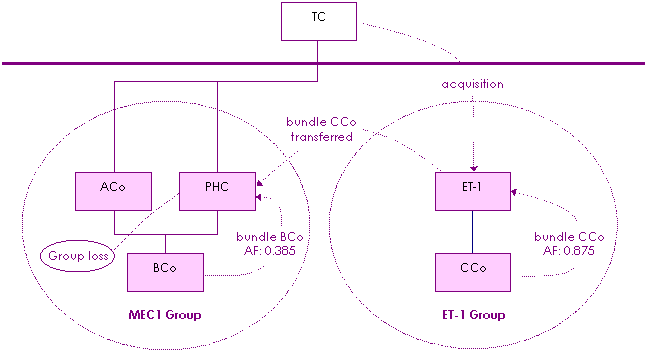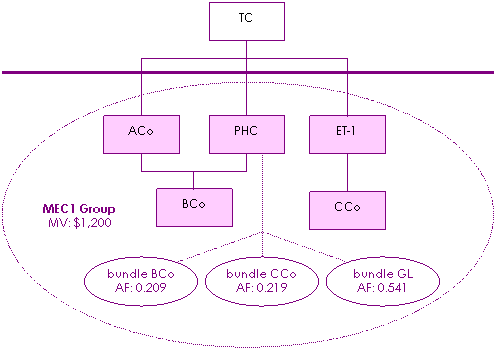Consolidation Reference Manual
You can still refer to the Consolidation reference manual for consolidation information that has not been impacted by changes in the legislation.
C10 MEC groups
C10-2 Worked example
Losses
C10-2-310 Adjusting available fraction - a new eligible tier-1 company joins a MEC group
Description
This example shows how, where a new eligible tier-1 company joins an existing multiple entry consolidated (MEC) group, the MEC group:
- •
- establishes an available fraction for any prior year group losses, and
- •
- adjusts all existing available fractions to take into account the entry of the new company.
- •
- MEC groups → C10-1
- •
- loss bundles and calculating the available fraction → 'Treatment of losses', C3-1 ; 'Consolidation loss provisions', C3-2-110 (worked example)
- •
- working out modified market value → 'Modified market value of a single joining entity', C3-4-110 (worked example)
- •
- market values → 'Market valuation guidelines', C4-1
Commentary
Generally, available fractions for MEC groups are calculated and adjusted in the same way as they are for ordinary consolidated groups. However, a group's existing available fractions are adjusted if the group expands because a new eligible tier-1 company ( → section 719-15) joins the group. Also, any prior year losses generated by the group (group losses) prior to the eligible tier-1 company joining are treated as transferred losses from the joining time of the new eligible tier-1 company.
Adjusting existing available fractions
The inclusion of a new eligible tier-1 company in a MEC group increases the group's income generating capacity, which reduces the proportion of the group's income that the original loss entities can be regarded as generating. The increase in the group's income generating capacity occurs because the group has not exchanged cash or assets (or increased liabilities) to bring the eligible tier-1 company into the group. As the foreign parent (the 'top company') finances the acquisition, capital has effectively been injected into the group. Hence, all existing available fractions must be adjusted.
The available fraction for each bundle of previously transferred losses is adjusted by multiplying it by the following factor ('market value factor'):
((market value of the existing group just before the eligible tier-1 company joins) /( market value of the expanded group just after the eligible tier-1 company joins))
Calculating an available fraction for prior year group losses
Any group losses held by a MEC group at the time an eligible tier-1 company joins are treated as though they are transferred losses of the expanded group. [F1] This ensures they form a loss bundle for which an available fraction is calculated. Subdivision 707-C then applies in determining how much of the losses can be used for an income year (in the same way that Subdivision applies to other transferred losses). This broadly ensures that the group losses can only be utilised against the portion of the group's income and gains generated by the entities that contributed to the making of the loss.
The available fraction for prior year group losses is calculated under subsection 707-320(1) as follows:
((modified market value of the real loss-maker) / (transferee's adjusted market value))
The real loss-maker (the head company of the original group that made the loss) works out its modified market value as if each subsidiary member of the original group at the time the eligible tier-1 company joins were a part of the head company. → subsection 719-305(3)
The transferee's adjusted market value includes all of the group members, including those that join as a result of the eligible tier-1 company joining the group. [F2]
Capping the available fractions
The original group may have both group losses and previously transferred losses when the new eligible tier-1 company joins. In these situations, available fractions are capped so that their total does not exceed what would otherwise be the available fraction for the group loss bundle. The available fraction for each bundle is adjusted by multiplying it by the following factor ('capping adjustment factor'):
((available fraction for the group loss bundle) / (sum of the available fractions for the group loss bundle and the (adjusted) available fractions for the existing transferred loss bundles))
This adjustment ensures available fractions bear the correct proportion to each other. [F3]
Example
Facts
ET-1 Group consolidates on 1 July 2003. A loss made by subsidiary member CCo is transferred to the head company, ET-1, at the time the group consolidates. An available fraction of 0.875 is established for bundle CCo at the initial transfer time.
MEC1 Group consists of a provisional head company - PHC - and two other companies, ACo and BCo. A loss made by BCo is transferred to PHC when BCo joins the group. An available fraction of 0.385 is established for bundle BCo at the initial transfer time. MEC1 Group also incurs a group loss for the 2004 income year.
The top company - TC - of MEC1 Group acquires ET-1 Group on 1 July 2004. A choice is made to expand MEC1 Group to include ET-1 and CCo.
→ subsection 719-5(4); 'Choice on formation and special conversion events', C10-2-110
When ET-1 Group joins MEC1 Group, the loss in bundle CCo is transferred to PHC.
This sequence of events is shown in figure 1. MEC1 Group must establish an available fraction for the prior year group loss and adjust all available fractions in recognition of the entry of ET-1 Group.
Figure 1: TC acquires ET-1 Group

Market values are ascertained as at the time of ET-1 Group joining (1 July 2004) as follows:
- •
- market value of ET-1 Group = $300
- •
- market value of MEC1 Group = $900
- (excluding the market value of ET-1 Group)
- •
- market value of MEC1 Group = $1,200
- (including the market value of ET-1 Group)
- •
- modified market value of PHC = $810
- (as the real loss-maker)
- •
- adjusted market value of PHC = $1,080
- (as the transferee)
Calculation
Step 1 - Establish the available fraction for the group loss bundle (bundle GL):
(810 / 1,080) = 0.750
Step 2 - Adjust the available fraction for bundle BCo by multiplying it by the market value factor:
(0.385 * (900 / 1,200)) = 0.289
The sum of available fractions for bundles GL and BCo is 1.039 (0.750 + 0.289). This figure will be the denominator of the capping adjustment factor.
Step 3 - Cap the available fractions for bundles GL and BCo by multiplying each by the capping adjustment factor: [F4]
GL: (0.750 * (0.750 / 1.039)) = 0.541
BCo: (0.289 * (0.750 / 1.039)) = 0.209
The sum of the available fractions for bundles held by PHC is 0.750 (0.541 + 0.209). This corresponds with the available fraction initially calculated for bundle GL.
Step 4 - Adjust the available fraction for bundle CCo under item 1 in the table in subsection 707-320(2):
(0.875 * (300 / 1,200)) = 0.219
There is no need to further adjust the available fraction for bundles GL and BCo as a result of bundle CCo being transferred. Item 3 in the table in subsection 707-320(2) [F5] does not apply when a new eligible tier-1 company joins a group, regardless of whether the new eligible tier-1 company or any of its subsidiaries are loss entities. → subsection 719-310(3)
The utilisation of the losses in all bundles for the 2005 income year is subject to limits determined by reference to the available fraction method.
The expanded MEC1 Group structure just after ET-1 Group joins is shown in figure 2.
Figure 2: The expanded MEC1 Group

References
Income Tax Assessment Act 1997 - as amended by New Business Tax System (Consolidation) Act (No. 1) 2002 (No. 68 of 2002), Schedule 1:
Income Tax Assessment Act 1997, Subdivision 719-F; as amended by New Business Tax System (Consolidation and Other Measures) Act (No. 1) 2002 (No. 117 of 2002), Schedule 8
Income Tax (Transitional Provisions) Act 1997, Subdivision 719-F; as amended by New Business Tax System (Consolidation and Other Measures) Act (No. 1) 2002 (No. 117 of 2002), Schedule 10
Income Tax (Transitional Provisions) Act 1997 , section 707-C ; as amended by Tax Laws Amendment (2005 Measures No. 5) Act 2005 (162 of 2005), Schedule 3 , Part 2
Explanatory Memorandum to the New Business Tax System (Consolidation) Bill (No. 1) 2002, Chapter 8
History
Revision history
Section C10-2-310 first published 2 December 2002 and updated 28 May 2003.
Further revisions are described below.
| Date | Amendment | Reason |
|---|---|---|
| 26.10.05 | Government announces extension of time for head companies to make or revoke certain elections, p. 2. | Proposed legislative amendment. |
| 12.9.06 | Extension of time to revoke election to cancel a loss, footnote 4. | Legislative amendment. |
Proposed changes to consolidation
Proposed changes to consolidation announced by the Government are not incorporated into the Consolidation reference manual until they become law. In the interim, information about such changes can be viewed at:
- •
- http://assistant.treasurer.gov.au (Assistant Treasurer's press releases)
- •
- www.treasury.gov.au (Treasury papers on refinements to the consolidation regime).
Current at 12 September 2006
These group losses are not actually tested and transferred, just treated as if they had passed the transfer tests and were transferred under Subdivision 707-A of the ITAA 1997.
As a result of the single entity rule in section 701-1 of the ITAA 1997.
This adjustment mirrors adjustment item 2 in the table in subsection 707-320(2) of the ITAA 1997. That item caps the available fractions for bundles transferred from the head company of a group that is acquired by another group.
The group may avoid the application of step 3 by choosing to cancel the loss in bundle GL. Broadly, the effect of cancellation is that the cancelled loss could be used up until ET-1 joins but cannot be used thereafter. The choice to cancel a loss is contained in section 719-325. The choice to cancel a loss may be revoked where the revocation takes place before 1 January 2006.
Applies to adjust the available fractions of existing loss bundles when another loss bundle is transferred to the group at a later time.
